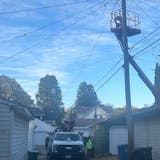Opinion editor’s note: Star Tribune Opinion publishes a mix of national and local commentaries online and in print each day. To contribute, click here.
•••
The 2012 agreement to raise funding for the $1.1 billion U.S. Bank Stadium had three parts. The Minnesota Vikings committed $600 million, Minneapolis committed $150 million and legislators expected $350 million from electronic pulltabs (e-tabs) once legalized. Key players in the agreement were the tribal nations of Minnesota. Their support was conditioned on a commitment that e-tabs would mimic paper pulltabs to avoid competition with casino video games and slot machines. Without their support, a different source of funding would have been challenging to find.
During the last legislative session, legislators strengthened the feature restrictions. Advocates said that these restrictions were required in order to comply with the original political compromise. While allowing more e-tab features has political hurdles to overcome, the Legislature and Gov. Tim Walz are 100% in control of taxes. So let’s talk about taxes.
In 2023, Minnesota taxed nonprofits who use gambling to fund their missions $193 million. This gambling tax averaged just over 29% of net revenue, according to annual reports from the state’s Gambling Control Board (GCB). Imagine paying income taxes on revenue instead of income. Sales taxes are based on revenue, too, but the sales tax rate is “only” 6.875% (and added to the customer’s bill). According to the GCB, allowable expenses to provide for gambling (cost of pulltabs, software fees for e-tabs, labor, rent, etc.) were 50% of net revenue. Once expenses are subtracted from net revenue, the $193 million tax equates to an average income tax rate of 58%. That is not a typo. As a point of reference, Nevada taxes for-profit casinos at 6.75% of net revenue.
Why are the rates so high? Confusion is a possibility. Percentages and rates are only meaningful if matched against a specific value. Is $70 billion a good or bad number? Is 40% a good or bad percentage? Most people understand the importance of context, but fewer understand context when it comes to explaining numbers and percentages. Of course, sometimes the exclusion of context is purposeful, but that is for a different commentary.
While confusion is a possibility, legislators had a specific purpose in mind. Funding the stadium was the catalyst for the legalization of e-tabs in 2012, and it would have been counter to the very intent of the bill to leave those dollars in the hands of local nonprofits. However, now that the stadium has been paid off, a compelling case can be made that local nonprofits can leverage their donations for the good of the community far more effectively than can the state of Minnesota.
Nonprofits cannot replace the core responsibilities of government, but 1,144 nonprofits are better at getting the most out of a small pot of money, especially in local communities. Politicians can write volumes of laws in a matter of weeks, but nimble execution is not a government strength, especially when outside of its core responsibilities. Governments spend substantial resources focused on compliance, while nonprofits and charities focus on results. The cultures of well-run nonprofits routinely support the incorporation of feedback into their operations, sometimes in formal ways, but often informally. Incorporating timely feedback (what’s working, what’s not working) creates a cycle of continuous improvement that directly benefits local communities, especially for the young people, the veterans, the homeless and the hungry. While the taxes raised through gambling are a rounding error relative to state spending, it is a huge amount for nonprofits and the charities they support.


